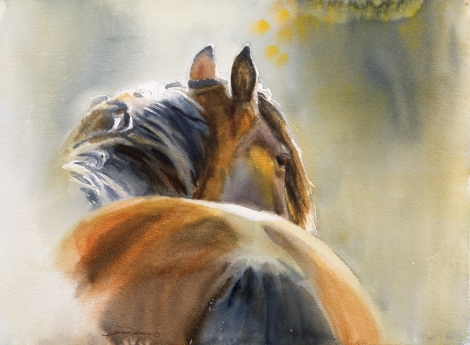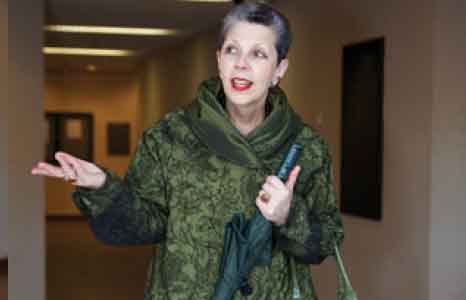There’s a lovely softness to Susan Dorazio’s art – a feathery texture, a diffusion of light born of a careful layering of paints, classical training and her own powers of observation.
In the painting of the horse that opens her website and pulls you in, the satisfying curves of his neck and rump seem to fade into a light-dappled day. Dorazio specializes in portraits and equine and sporting art. So which subjects are more demanding – the two-legged or the four-legged kind?
“They’re both just as challenging,” she says. “It depends on the people I’m working with.”
Like many who love animals, though, she says she sometimes prefers them to humans.
“They’re very honest and they’re real, especially dogs,” she says.
Her portraits of dogs – heads cocked jauntily, looking at the viewer with soulful eyes – and those of horses, interacting gently with children and dogs, reflect that authenticity.
Dorazio, who has a studio in her Colebrook, Conn. home, begins not only by photographing her subjects but by talking with them – or those who can speak for them. For her painting of three boys in a landscape, ages 3 to 10, she relied on their mother’s comments about them.
“All the things she said came out in the photo shoot,” Dorazio says. “That meant a lot to me.”
Her relationship with her clients doesn’t stop there.
“Before I begin, I have the client over and review the photos to help make a decision about a look or a pose. There are always points that I didn’t know. It’s the dessert of my information.”
Having had “dessert,” Dorazio will make a pencil sketch of her subject and then a color study in whatever medium she’ll use for the final work – watercolors, oils or acrylics.
“I enjoy all of them, although it’s difficult for me to switch from one to another, especially watercolor to oil.”
So she tries to do all her work in one medium first before moving on to another. Traditionally, watercolor is considered a light medium that dries quickly and requires fast work, while oils, which can be applied thickly, are well-suited to impasto and texture. But Dorazio layers on her watercolors to give that medium a density and solidity it lacks in other artists’ hands.
It’s the kind of technique that results from classical training. Dorazio – who grew up in Mount Kisco as a quiet, creative child in love with animals and art – received hers at the Silvermine School of Art in New Canaan and the University of Bridgeport.
“Silvermine really opened my eyes,” she says, referring to the way that some of the professors left it up to the students to interpret the assignments. They would then critique the work.
Though she also had very structured classes, Dorazio says that her more free-form training honed her independent-mindedness and powers of observation. And while she says she’s in awe of the classical and contemporary artists in such museums as Hartford’s Wadsworth Atheneum and Francine and Sterling Clark Art Institute in Williamstown, Mass., her greatest influences are her observations of people and nature. (The opening image on her website, for instance, was the result of seeing a horse in a field while she was out with a friend.)
Imagination and memory also have their place in her work. Dorazio tells the story of a client whose big, black dressage horse she painted in the 1980s. The horse aged and the client had to put him down. She wanted a portrait of him in his stall as he was later in life.
It wasn’t easy working from photographs in this case, Dorazio says. The backlighting was kind of purple; the horse, thin and gray.
“But he still had a sparkle in his eye,” she says, and the client was adamant.
“We worked together on this,” Dorazio says. “She said, ‘You’re the only artist who can do this,’ and I said, ‘You’re putting a lot of pressure on me.”
Talking to her, you get the sense that Dorazio puts a lot of pressure on herself.
“I can’t let anything go unless it’s 100 percent.”
So Dorazio was more than a bit eager when she emailed the client images of the final work. She loved it beyond words. Dorazio must’ve been happy with that response, right?
“Oh, God, yes, it just made me feel relieved, wonderful.”
Susan Dorazio is represented by the Handwright Gallery & Framing in New Canaan, the P S Gallery in Litchfield and the Decoys & Wildlife Gallery in Frenchtown, N.J. In addition to her fine art, she draws the cartoon “Rail Talk,” written by Jan Lynick. It is featured monthly in Saddle & Bridle magazine, the Equine Journal, and Draft Horse Journal. Her studio in Colebrook, Conn. is open year-round by appointment. For more, visit susandorazio.com.



